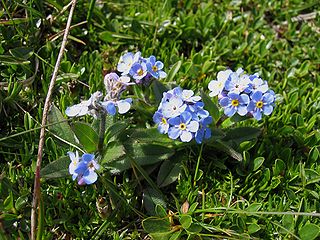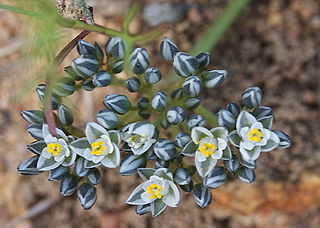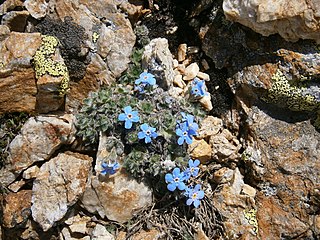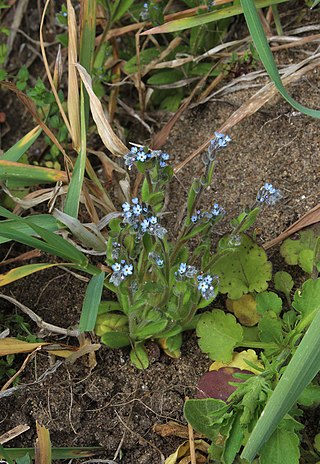
Boraginaceae, the borage or forget-me-notfamily, includes about 2,000 species of shrubs, trees, and herbs in 146 to 156 genera with a worldwide distribution.

Myosotis is a genus of flowering plants in the family Boraginaceae. The name comes from the Ancient Greek μυοσωτίς "mouse's ear", which the foliage is thought to resemble. In the Northern Hemisphere, they are colloquially known as forget-me-nots or scorpion grasses. Myosotis alpestris is the official flower of Alaska and Dalsland, Sweden. Plants of the genus are commonly confused with Chatham Islands' forget-me-nots, which belong to the related genus Myosotidium.

Myosotis alpestris or alpine forget-me-not is a herbaceous perennial plant in the flowering plant family Boraginaceae.

Myosotis scorpioides, the true forget-me-not or water forget-me-not, is a herbaceous perennial flowering plant in the borage family, Boraginaceae.

Myosotis nemorosa is a plant species of the genus Myosotis. They are native to most of mainland Europe.

Myosotis stricta is a plant species of the genus Myosotis. Common names include strict forget-me-not and blue scorpion grass.

Hesperevax sparsiflora is a species of flowering plant in the family Asteraceae known by the common name erect dwarf cudweed. It is native to California and Oregon, where it grows in several habitat types including sandy coastal areas and the serpentine soils of inland hills. This is a small woolly annual herb reaching maximum heights under 18 centimeters. It has oval to rounded or scoop-shaped leaves on short petioles which vary in morphology across varieties. Small flower heads appear between the leaves. They contain greenish or whitish disc florets.These florets are remarkably small, each being only 1/120th of an inch in width, and numbering 5 to 9 in the whole disc, which totals only 1/ 6th inch in width including bracts. This is the world's smallest composite inflorescence.

Collinsia sparsiflora is a flowering plant in the family Plantaginaceae known by the common names spinster's blue-eyed Mary and few-flowered collinsia. One variety of the species is native to the West Coast of the United States as far north as Washington, while the other three varieties are limited to California alone.

Limeum is a genus of flowering plants. It includes 25 species.

Alpine forget-me-not is a common name for several plants in the Boraginaceae (forget-me-not) family and may refer to:

Melaleuca sparsiflora is a shrub in the myrtle family Myrtaceae, and is endemic to the south-west of Western Australia. It generally grows in heavy soils on the edges of salt lakes and has only one or two flowers at the ends of it branches, unlike the many-flowered heads or spikes of others in the genus Melaleuca.

Carlos Adolfo Lehnebach is a New Zealand botanist. He is employed as a botany curator at the Museum of New Zealand Te Papa Tongarewa. Lehnebach has a master's degree and a PhD from Massey University.

Saurauia sparsiflora is a species of flowering plant in the family Actinidiaceae. It is endemic to the Philippines. It was discovered on Mount Santo Tomas by Adolph Daniel Edward Elmer, the American botanist who first formally described the species, and named it after the small number, or sparse, flowers in its inflorescences.

Myosotis abyssinica is a species of plant in the family Boraginaceae. It can be found in Ethiopia, Sudan, Bioko Island, Rwanda, the Democratic Republic of Congo (Zaire), Uganda, Kenya, Tanzania, and Cameroon.

Myosotis micrantha is a species of flowering plant belonging to the family Boraginaceae.

Myosotis rehsteineri is a species of flowering plant belonging to the family Boraginaceae.
Crassothonna is a genus of flowering plants belonging to the family Asteraceae.

Myosotis dissitiflora is a species of forget-me-not native to the Caucasus. It is one of the largest-flowered species in Myosotis. There used to be a dozen of ornamental cultivars during the late 19th and early 20th centuries, but they are all lost now. Currently there exist two known cultivars, namely 'Baby Blue' and 'Myomark'.

Myosotis rakiura is a species of flowering plant in the family Boraginaceae, endemic to southern South Island and Stewart Island/Rakiura of New Zealand. Joseph Beattie Armstrong described the species in 1881. Plants of this species of forget-me-not are perennial rosettes which form loose tufts or clumps, with ebracteate, erect inflorescences, and white corollas with exserted stamens.


















